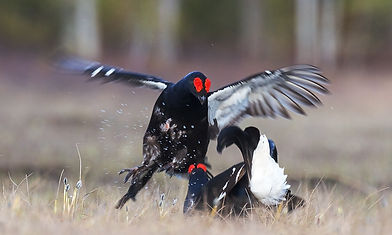
provider of specialist ecological services
Project Case Studies
Since launching TETRIX Ecology back in 2017, we've been busy supporting a diverse portfolio of project work throughout the length and breadth of Scotland, for example, from bat roost surveys in West Dunbartonshire and pre-works checks for protected species in Stirlingshire, to upland breeding bird surveys in the Scottish Borders, surveys for lekking black grouse in Argyll and Bute and Scottish wildcat surveys in Aberdeenshire. We've also been busy outside of Scotland undertaking voluntary bat survey and monitoring works in Epping Forest, while further afield, we've also been over-sees in Asia undertaking some very interesting bat survey work in north-east Thailand! One thing's for sure, we've definitely had a productive and thoroughly enjoyable three years!
Given all of the great work we've been undertaking for our clients, we decided it was high time we started sharing some of our ecological work-related experiences to the wider community in the form of some relevant case studies! The format is simple... For each case study, we have provided a relevant image and short narrative describing the work we've been undertaking at home and abroad. Naturally it goes without saying that we'll be adding exciting new cases studies here in the future, so keep your eyes peeled and keep coming back!

Preliminary (Bat) Roost Assessment
West Dunbartonshire, scotland
We completed a Preliminary (Bat) Roost Assessment in line with Bat Conservation Trust good practice guidelines at a site in West Dunbartonshire. The assessment sought to establish the presence of built and natural features that showed either direct evidence of roosting bats or features which were potentially suitable for roosting. The results of the assessment were used to inform the requirement for supplementary bat survey effort. In the attached photograph, you can see our Principal Ecologist and Licensed Bat Worker (Graham Sennhauser) examining a Potential Roosting Feature (PRF) in a beech tree for evidence of roosting bats.
Image Credit: TETRIX Ecology

Black Grouse Lek
Survey
Argyll and bute, scotland
We recently completed a Black Grouse Lek Survey at a site in Argyll and Bute taking cognisance of methods outlined in Bird Monitoring Methods (Gilbert et al, 1998). The survey sought to establish the presence of lekking male black grouse and attending female grouse within the site boundary and wider study area. Having identified three lekking sites, the results of the survey were used to design an appropriate working buffer to ensure continued use of the leks by grouse. An example of a displaying male black grouse with five attending female grouse, which we recorded on a site near Glasgow, can be viewed on our YouTube Channel.
Image Credit: Hans Veth (UnSplash)

Bat Survey and Bat Box Monitoring
Epping Forest, Essex
Our Licensed Bat Worker (Graham Sennhauser) recently participated in a working expedition to Epping Forest with nine other licensed bat workers from Scotland and two local licensed bat workers from Essex. The purpose of the expedition was to survey previously unsurveyed areas of Epping Forest for their bat populations. The work, which was completed under licensing from Natural England, established the presence of nine bat species, including the rare barbastelle bat (pictured).
Image Credit: TETRIX Ecology

Preliminary Ecological Appraisal
Angus, scotland
We completed a Preliminary Ecological Appraisal (PEA) at a site in Angus taking cognisance of good practice guidelines produced by the Chartered Institute of Ecology and Environmental Management (CIEEM). In addition to the presence of ancient woodland adjacent to the site boundary, the PEA established the presence of historical records and suitable habitat for badger, bats and red squirrel both within and adjacent to the site. As a consequence, recommendations were outlined for additional protected species survey effort. If you want to know more about PEA and the process then read our our blog at the following link.
Image Credit: TETRIX Ecology



